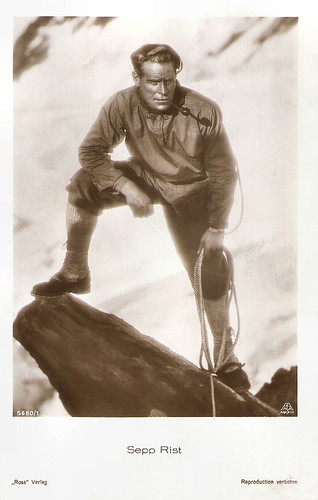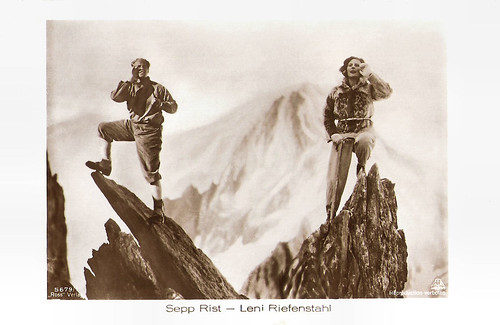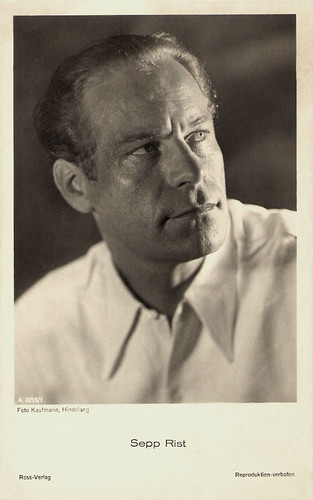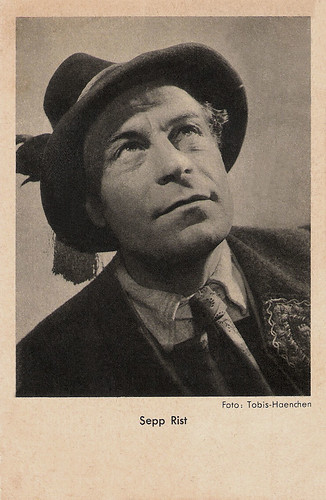Sepp Rist (1900-1980) was a top skier, who was spotted for the Mountain films by Arnold Fanck. Later the Athletic German actor with the typical tanned and weathered face played, hunters, foresters and other rugged characters in several Heimat films.

German postcard by Ross Verlag, no. 5680/1, 1930-1931. Photo: Aafa-Film. Publicity still for Stürme über dem Mont Blanc/Storm Over Mont Blanc (Arnold Fanck, 1930).
Sepp Rist was born in 1900 in Bad Hindelang in Bavaria. During the First World War, Rist was a stoker on a torpedo boat, and later radio telegrapher on the 1st Submarine Chaser-half-flotilla. From 1920 he worked for the Nuremberg police as a radio operator, and also worked temporarily at the airport in Fürth.
He was also a talented athlete who participated at the 1927 German Ski Championships in Garmisch-Partenkirchen and at other cross-country and jump skiing championships. At a ski race in Gurgl, cameraman Sepp Allgeier spotted him for the film.
Rist’s first film part was the male lead in Arnold Fanck's mountain film Stürme über dem Mont Blanc/Storm Over Mont Blanc (Arnold Fanck, 1930) opposite Leni Riefenstahl. Rist plays meteorologist Hannes who works alone at the Mont Blanc weather station gathering data. His only contact with the world below is via Morse code signals. He is joined by a woman friend, who helps him survive a terrible storm over the mountain.
Filmed on location in Arosa, Switzerland, Babelsberg Observatory in Potsdam, Germany, and Mont-Blanc in Chamonix, France, Wikipedia writes that Stürme über dem Mont Blanc is notable for its dramatic mountain footage and depictions of a violent snow storm. It was shot as a silent film and was later dubbed in the studio.
Stürme über dem Mont Blanc was followed by numerous other films in which Rist always embodied the seasoned Bavarian man image. He reunited with Fanck and Riefenstahl for the German-US drama S.O.S. Eisberg/S.O.S. Iceberg (Arnold Fanck, 1933).
S.O.S. Eisberg was a combination of Mountain film and Disaster film, written by Tom Reed based on a story by Arnold Fanck. An Arctic expedition goes in search of a party that was lost the previous year. S.O.S. Eisberg was filmed on location in Umanak, on the west coast of Greenland, in Iceland, and in the Bernina Alps, on the border between Italy and Switzerland. It was filmed simultaneously in German and English, and released by Universal Studios in both Germany and the United States. Rist appeared in both versions.
He appeared with Brigitte Horney in the Mountain film Der ewige Traum/The Eternal Dream (Arnold Fanck, 1934). In Die Reiter von Deutsch-Ostafrika/The Riders of German East Africa (Herbert Selpin, 1934), he played a German farmer in German East Africa, who is conscripted into the Schutztruppe (German armed colonial force) at the beginning of the First World War.
Rist also had a supporting part as a Gestapo commissioner in the propaganda film Verräter/The Traitor (Karl Ritter, 1936) starring Lída Baarová.

German postcard by Ross Verlag, no. 5679/1, 1930-1931. Photo: Aafa-Film. Publicity still for Stürme über dem Mont Blanc/Storm Over Mont Blanc (Arnold Fanck, 1930) with Leni Riefenstahl.
Quite the adventurer in real life, Sepp Rist was most at home filming in far-flung and exotic locations around the world. In Japan, he appeared in Kokumin no chikai/ The sacred goal (Hiromasa Nomura, 1938).
During the Second World War, Sepp Rist made the Heimat film Die Geierwally/Vulture-Wally (Hans Steinhoff, 1940) with Heidemarie Hatheyer, and Titanic (Werner Klingler, Herbert Selpin, 1943). Titanic used the sinking of the RMS Titanic as a setting for an attempt to discredit British and American capitalist dealings and glorify the bravery and selflessness of German men.
After the war, Sepp Rist frequently appeared in Heimat films, but only in small roles as hunters and foresters. He appeared in the American thriller The Devil Makes Three (Andrew Marton, 1952), set in post-World War II Germany, and starring Gene Kelly and Pier Angeli.
More recently, he played in episodes of such television series as the Krimi Der Kommissar/The Commissioner (1969-1970) with Erik Ode, and Königlich Bayerisches Amtsgericht/Royal Bavarian District Court (1970-1971).
His final films were the Heimat dramas Schloß Hubertus/Hubertus Castle (Harald Reinl, 1973) starring Robert Hoffmann, and Der Jäger von Fall/The Hunter from Fall (Harald Reinl, 1974).
Sepp Rist was married with actress Carla Rust. In 1980, he died at the age of 80 years. His wife had died three years before him.

German postcard by Ross Verlag, Berlin, no. A 3215/1, 1941-1944. Photo: Kaufmann, Hindelang.

German postcard by Das Programm von Heute für Film und Theater / Ross Verlag, Berlin. Photo: Tobis / Haenchen. Collection: Miss Mertens.
Sources: Stephanie D’heil (Steffi-line - German), Thomas Staedeli (Cyranos – German), Nicole Gagne (AllMovie), Wikipedia (German) and IMDb.

German postcard by Ross Verlag, no. 5680/1, 1930-1931. Photo: Aafa-Film. Publicity still for Stürme über dem Mont Blanc/Storm Over Mont Blanc (Arnold Fanck, 1930).
A violent snow storm
Sepp Rist was born in 1900 in Bad Hindelang in Bavaria. During the First World War, Rist was a stoker on a torpedo boat, and later radio telegrapher on the 1st Submarine Chaser-half-flotilla. From 1920 he worked for the Nuremberg police as a radio operator, and also worked temporarily at the airport in Fürth.
He was also a talented athlete who participated at the 1927 German Ski Championships in Garmisch-Partenkirchen and at other cross-country and jump skiing championships. At a ski race in Gurgl, cameraman Sepp Allgeier spotted him for the film.
Rist’s first film part was the male lead in Arnold Fanck's mountain film Stürme über dem Mont Blanc/Storm Over Mont Blanc (Arnold Fanck, 1930) opposite Leni Riefenstahl. Rist plays meteorologist Hannes who works alone at the Mont Blanc weather station gathering data. His only contact with the world below is via Morse code signals. He is joined by a woman friend, who helps him survive a terrible storm over the mountain.
Filmed on location in Arosa, Switzerland, Babelsberg Observatory in Potsdam, Germany, and Mont-Blanc in Chamonix, France, Wikipedia writes that Stürme über dem Mont Blanc is notable for its dramatic mountain footage and depictions of a violent snow storm. It was shot as a silent film and was later dubbed in the studio.
Stürme über dem Mont Blanc was followed by numerous other films in which Rist always embodied the seasoned Bavarian man image. He reunited with Fanck and Riefenstahl for the German-US drama S.O.S. Eisberg/S.O.S. Iceberg (Arnold Fanck, 1933).
S.O.S. Eisberg was a combination of Mountain film and Disaster film, written by Tom Reed based on a story by Arnold Fanck. An Arctic expedition goes in search of a party that was lost the previous year. S.O.S. Eisberg was filmed on location in Umanak, on the west coast of Greenland, in Iceland, and in the Bernina Alps, on the border between Italy and Switzerland. It was filmed simultaneously in German and English, and released by Universal Studios in both Germany and the United States. Rist appeared in both versions.
He appeared with Brigitte Horney in the Mountain film Der ewige Traum/The Eternal Dream (Arnold Fanck, 1934). In Die Reiter von Deutsch-Ostafrika/The Riders of German East Africa (Herbert Selpin, 1934), he played a German farmer in German East Africa, who is conscripted into the Schutztruppe (German armed colonial force) at the beginning of the First World War.
Rist also had a supporting part as a Gestapo commissioner in the propaganda film Verräter/The Traitor (Karl Ritter, 1936) starring Lída Baarová.

German postcard by Ross Verlag, no. 5679/1, 1930-1931. Photo: Aafa-Film. Publicity still for Stürme über dem Mont Blanc/Storm Over Mont Blanc (Arnold Fanck, 1930) with Leni Riefenstahl.
Filming in far-flung and exotic locations
Quite the adventurer in real life, Sepp Rist was most at home filming in far-flung and exotic locations around the world. In Japan, he appeared in Kokumin no chikai/ The sacred goal (Hiromasa Nomura, 1938).
During the Second World War, Sepp Rist made the Heimat film Die Geierwally/Vulture-Wally (Hans Steinhoff, 1940) with Heidemarie Hatheyer, and Titanic (Werner Klingler, Herbert Selpin, 1943). Titanic used the sinking of the RMS Titanic as a setting for an attempt to discredit British and American capitalist dealings and glorify the bravery and selflessness of German men.
After the war, Sepp Rist frequently appeared in Heimat films, but only in small roles as hunters and foresters. He appeared in the American thriller The Devil Makes Three (Andrew Marton, 1952), set in post-World War II Germany, and starring Gene Kelly and Pier Angeli.
More recently, he played in episodes of such television series as the Krimi Der Kommissar/The Commissioner (1969-1970) with Erik Ode, and Königlich Bayerisches Amtsgericht/Royal Bavarian District Court (1970-1971).
His final films were the Heimat dramas Schloß Hubertus/Hubertus Castle (Harald Reinl, 1973) starring Robert Hoffmann, and Der Jäger von Fall/The Hunter from Fall (Harald Reinl, 1974).
Sepp Rist was married with actress Carla Rust. In 1980, he died at the age of 80 years. His wife had died three years before him.

German postcard by Ross Verlag, Berlin, no. A 3215/1, 1941-1944. Photo: Kaufmann, Hindelang.

German postcard by Das Programm von Heute für Film und Theater / Ross Verlag, Berlin. Photo: Tobis / Haenchen. Collection: Miss Mertens.
Sources: Stephanie D’heil (Steffi-line - German), Thomas Staedeli (Cyranos – German), Nicole Gagne (AllMovie), Wikipedia (German) and IMDb.
No comments:
Post a Comment